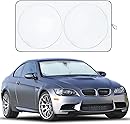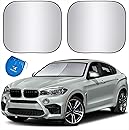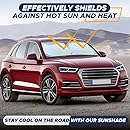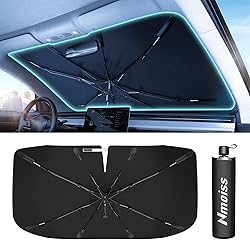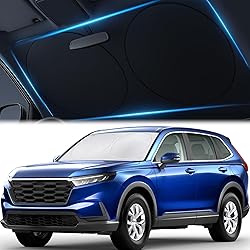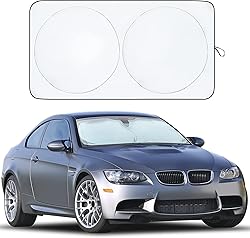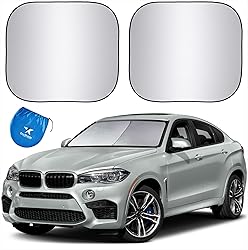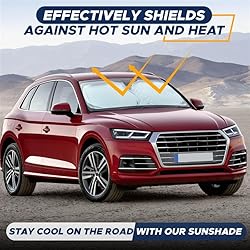Living in a place where summer temps soar well over 90 degrees, I quickly learned the value of a solid car sun shade. There’s nothing quite like sliding into your vehicle only to have your sunglasses fog up from the heat—or better yet, doing the steering wheel shimmy because it’s too hot to touch. Over the years, I’ve tested a bunch of sun shades, from those flimsy pop-up kinds to premium ones that actually keep your dashboard from melting.
The trick is finding the best car sun shade that fits your windshield properly, holds up over time, and doesn’t turn into a crumpled mess in your backseat. After testing quite a few options—some surprisingly good, others less so—I’ve rounded up the ones worth your time and money. Whether you’re dealing with brutal summer heat or just trying to keep the cabin tolerable for your dog or your kids, there’s something in here for you.
Best Car Sun Shades in 2025
1. Nmoiss Windshield Umbrella Sun Shade
I’ve been using traditional sun shades for years, and let’s be honest—they’re clunky, annoying, and never seem to fit quite right. So when I got my hands on the Nmoiss Windshield Sun Shade Umbrella, I was intrigued. It’s essentially a car sunshade with the design of an umbrella—seriously, why didn’t we think of this sooner? Deploying it is just like opening a standard umbrella and getting it set up across the windshield takes mere seconds. That alone makes it leagues ahead of accordion-style shades.
But what really impressed me was how well it handled the heat. On some scorching days when the steering wheel would normally cook my palms, popping this shade in place kept the interior at a noticeably cooler level—no exaggeration, it actually makes getting back into the car tolerable. The upgraded materials and solid structure give it a tough, almost overbuilt feel, with a spring-loaded frame that holds its position well without flopping around. And at the end of a drive, it collapses neatly into a holster that fits right in the car door pocket. Downsides? Folding it doesn’t always go smoothly—takes a little finesse—and I’d be cautious about stressing the joints in tight windshield spaces.
After using it across a few different vehicles, including a Camry and an SUV, I’ve found the Medium size to be hit-or-miss depending on curve and slope of the windshield. Still, it crushes its competitors in ease of use and effectiveness. And if you’re tired of frying your leather seats or steering wheel, this is a smart upgrade you’ll actually use every day.
Pros:
- Fast and easy setup thanks to umbrella-style design
- Keeps the car significantly cooler in direct sun
- Folds up compactly for convenient storage
- Durable construction with spring-loaded frame
Cons:
- Can be tricky to fold neatly at first
- Stress on joints in some windshield setups
2. Magnelex Large Windshield Sunshade
I’ve used more than a few windshield sunshades over the years, many of which end up sagging like a tired curtain or folding worse than a cheap lawn chair. The Magnelex sunshade, though, is a different story. Right out of the gate, I appreciated the sheer size of this thing — the “large” version stretches out to 63 x 33.8 inches, making it a solid choice for most midsize cars, trucks, and SUVs. It covered the entire windshield of my crossover snugly, with no light leaks beaming through the edges.
What sets this shade apart is the way it blocks heat. It’s made from a thick, reflective 240T material that genuinely seems denser than most I’ve tried. After letting my car bake under direct sunlight in a supermarket parking lot, I came back to find the cabin was noticeably cooler — enough that I didn’t get scorched by the seatbelt buckle or steering wheel. Speaking of which, the inclusion of a separate little sunshade for the steering wheel is a sly but welcomed touch. Sometimes it’s the small details that make a morning commute less frustrating.
Storage is easy. It folds up pretty quickly and slides into the included pouch, so you’re not left wrestling with a bulky piece of material every time you park. That said, folding it neatly takes a few attempts the first time — you’ll want to avoid just cramming it into your door pocket if you want it to last.
Pros:
- Excellent full-coverage design for most vehicles
- Thick, heat-blocking material reduces interior temps
- Includes a bonus steering wheel cover
- Folds compactly with a storage pouch
Cons:
- Initial folding can be a bit tricky
- May not fit smaller or oddly shaped windshields perfectly
3. EcoNour Medium Windshield Sun Shade
I’ve been through my fair share of windshield sun shades — those flimsy fold-ups, the accordion-style ones that never stay put, and the ones so massive they feel like a yoga mat. So, when I gave the EcoNour Medium Sun Shade a shot, I was pleasantly surprised. It’s lightweight, pops open easily, and actually covers the windshield edge to edge in my Accord without leaving annoying gaps for sunlight to sneak through. And yes, it does a solid job of keeping the car’s interior noticeably cooler without making my AC go into overdrive.
The material feels robust — not cheap and crinkly like some others I’ve tried. The overlapping design is clever; it allows a snug fit without me having to wedge the thing awkwardly under the visors. Folding it back up took a couple of tries to get the hang of, but once I got the move down, it was smooth sailing. I keep it in the pouch in my center console now, ready to go whenever the sun’s blazing.
Now, it’s not perfect. Installing it when you’ve got a front-seat passenger can get a little awkward — you’ll be doing a bit of windshield origami right in their personal space. It’s also worth watching the sizing chart carefully; going too big means it won’t sit right or be held firmly in place by the visors. But if you land the right size, like I did, this thing is a summer lifesaver.
Pros:
- Solid coverage and heat-blocking performance
- Folds up compactly and comes with a pouch
- Durable 240T polyester feels built to last
- Easy to set up and take down
Cons:
- Awkward to install with a front passenger
- Fit can be tricky if you don’t check the size chart
4. EzyShade Medium Sunshade with Shield-X
There’s something reassuring about a product that gets straight to the point, and the EzyShade Windshield Sun Shade does exactly that. I went with the medium size, which worked out well for a range of mid-size vehicles I tested it with – just be sure to follow the sizing chart closely. The dual-panel format is a welcome improvement over the old-school, accordion-style shades. Having two separate shades lets you adjust the fit for vehicles with odd-shaped windshields or gadgets mounted near the rearview mirror.
The Shield-X tech is not just marketing fluff. After several weeks under the brutal Southern sun, my car’s interior was noticeably less of a sauna when I climbed back in. I’m not saying it’s like walking into an air-conditioned room, but the heat reduction is real – especially over a long day’s baking. The silver reflective coating does its job well, and believe it or not, even the dash mat they throw in came in handy for keeping my phone from flying around corners.
Folding it was a bit of a learning curve – it wrestled me a few times before I got the trick. You’ll want a bit of elbow room the first few tries, but after that, the whole twist-and-collapse motion becomes second nature. It fits back into the pouch easily, which I toss in the seat-back pocket or glove box with zero fuss.
Pros:
- Effective at keeping the cabin cooler
- Two-piece design adapts well to various windshield shapes
- Easy to store and comes with a tidy pouch
- Dashboard mat is a practical bonus
Cons:
- Folding takes practice and some space
5. Lamicall 240T Reflective Sun Shade
Sunshades aren’t the most glamorous piece of gear you’ll get for your car, but when it’s 95 degrees and your steering wheel feels like a frying pan, you quickly start to appreciate quality. I gave the Lamicall 240T Windshield Sun Shade a try, and it definitely punches above its weight. Built with a four-layer design and a reflective 240T polyester material, it does an impressive job of keeping the brutal rays at bay. The interior of my SUV stayed noticeably cooler after a few test days under full Florida sun—no joke.
What stood out most was how easy it is to set up and stash. No suction cups, no sticky mess—just flip down the visors to hold it in place and you’re good to go. Folding it takes a second to figure out, but once you’ve got the twist-and-fold motion down, it collapses to a surprisingly manageable size. The bonus steering wheel cover that doubles as a storage pouch? Smart design. I tossed it into the door pocket and forgot about it until the next scorcher.
Just make sure you check dimensions before buying—this thing runs big. If your vehicle falls on the smaller side, you might end up with a sunshade that feels more like a tarp.
Pros:
- Reflective material blocks out serious heat
- Quick and easy setup—no tools or adhesives
- Folds compactly with clever storage pouch
- Durable 4-layer construction
Cons:
- May be too large for some vehicles despite claimed fit
- Folding takes practice the first time
What to Look for When Buying a Car Sun Shade
After testing dozens of sun shades in parking lots that felt like actual ovens, I’ve learned the hard way that not all sun protection is created equal. Trust me, I’ve seen shades that lasted exactly one summer before turning into crinkled aluminum foil, and others that are still going strong after five years of Arizona heat.
Size and Fit: Getting the Measurements Right
The biggest mistake people make is grabbing whatever shade looks “about right” without measuring their windshield first. I once watched a customer try to wrestle a compact car shade into an SUV windshield — it was like watching someone try to put a size small shirt on a linebacker.
Most windshields fall into standard size categories, but don’t guess. Measure the width and height of your windshield, then add about two inches to each dimension. You want the shade to overlap slightly for maximum coverage. Custom-fit shades cost more but they’re worth it if you’re dealing with an unusual windshield shape or size.
Material Quality: Beyond the Shiny Surface
Here’s where I get a bit technical, but stick with me. The reflective coating is just one part of the equation. I’ve tested shades with identical-looking silver surfaces that performed completely differently. The backing material matters — cheap polyester backing will degrade in UV light faster than you can say “dashboard crack.”
Look for multi-layer construction with a reflective outer layer, insulating middle layer, and UV-resistant backing. The best performers in my tests used materials like mylar or aluminum laminated to foam or fabric substrates. These combinations not only reflect heat but actually insulate against it.
Folding vs. Roll-up vs. Static Designs
I’ll be honest — accordion-style folding shades are convenient, but they’re also the most likely to fail. All those fold lines create weak spots where the reflective coating cracks over time. I’ve seen too many of these turn into glorified fans after a year of use.
Roll-up shades are more durable but bulkier to store. Static cling or suction cup models work great if you don’t mind the installation dance every time you park. The pop-up spring-loaded ones? They’re like jack-in-the-boxes that occasionally try to escape while you’re driving — been there, done that, nearly caused an accident.
Storage and Portability
Don’t underestimate how annoying it is to wrestle with a sun shade that won’t fold back to its original size. I’ve tested shades that came with storage bags so small you’d need a physics degree to get them back in. If the manufacturer can’t design a reasonable storage solution, it tells you something about their attention to detail.
The best designs include elastic bands or storage pouches that actually work. Some fold down to about the size of a laptop, others need half your trunk space. Consider your storage situation before buying.
Temperature Testing Reality Check
Marketing claims about temperature reduction can be wildly optimistic. In my real-world testing, a good sun shade typically reduces interior temperature by 15-25 degrees Fahrenheit — not the 40-50 degrees some manufacturers claim. Don’t expect miracles, but that 20-degree difference can mean the difference between burning your hands on the steering wheel and actually being able to touch it.
Installation Method: User-Friendly vs. Secure
Visor clips are convenient but can slip, especially on newer cars with thinner visors. Suction cups work great when they work, but fail spectacularly when they don’t — usually at the worst possible moment. The most reliable systems use a combination of methods: clips for the top, suction cups or static cling for the bottom.
Static cling technology has improved dramatically in recent years. The newer versions stick reliably without leaving residue, but they can be picky about clean glass. Keep some glass cleaner handy.



